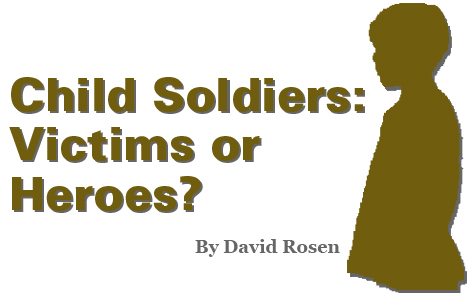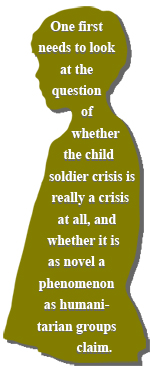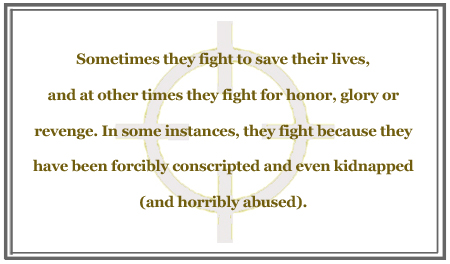


The presence of child soldiers in small-scale conflicts throughout the world has become a global humanitarian crisis and a media sensation. Television and magazines supply pumped-up images of cigar-smoking, gun-toting 11-year-olds while official reports from the United Nations and a host of human rights organizations expose alarming details of what is usually described as a “growing phenomenon.” But is this really something new?
Humanitarian organizations and the news media offer up two seemingly contradictory images of child soldiers: one, as exploited victims of adult abuse of power and, two, as enraged, virtually uncontrollable killers. (The term “child soldier,” as used here, refers to those below the age of 18.) There are many examples. Ismael Baeh, a child soldier forcibly recruited into the Sierra Leone army at age 14, described his recruitment as follows: “I either had to join the Sierra Leone army or be killed — it was the only way to survive and to be alive. First of all they gave me a brief training in how to use a weapon, a G-3 gun. Next thing you knew you were on the front line … When we got there we were in an ambush — the rebels were attacking where we were in the bush. I did not shoot my gun at first — but when you looked around and saw your schoolmates younger than you, crying while they were dying … there was no option but to start pulling the trigger.”
A Growing Crisis?
Baeh’s narrative of victimization and abuse at the hands of the Sierra Leone army was used by the Coalition to Stop the Use of Child Soldiers to launch its Global Report 2001 on child soldiers. But it is not the only story of child soldiers. Sebastian Junger’s account of the battle for Freetown [capital of Sierra Leone] takes a decidedly darker turn. “War,” Junger tells us, “does not get worse than on January 6, 1999. Teenage soldiers out of their minds on drugs, rounded up entire neighborhoods and machine-gunned them or burned them alive in their homes … They killed people who refused to give them money, or people who didn’t give them enough money, or people who looked at them wrong … They favored Tupac T-shirts and fancy haircuts and … had been fighting since they were 8 or 9, some of them, and sported names such as Colonel Bloodshed, Commander Cut Hands, Superman, Mr. Die, and Captain Backblast.” [“Terror Recorded,” Vanity Fair, October 2000, 366–69.]


These two descriptions of children at war — on the face of it so different from one another — are in fact part of the same representation of children: a depiction that denies children social and moral agency or accountability. Monster or victim, contemporary images of child soldiers are filled with allusions to the children of Village of the Damned or Lord of the Flies. Their power for good and evil lies outside them — either in the alien invaders of their bodies, their drug-crazed minds or in their regression to unsocialized unmediated evil. The broadcasting of stock-in-trade images of evil children drawn from western horror narratives should at least give us pause. These depictions of children as angels or demons tell us very little about children or about the wars in which they participate.
To assess the situation, one first needs to look at the question of whether the child soldier crisis is really a crisis at all, and whether it is as novel a phenomenon as humanitarian groups claim. This, of course, is not to argue that it is good for children to be involved in war or that war itself is either necessary or desirable. But it does attempt to answer the question of whether the current involvement of children in combat reflects a substantive historical shift in the role of children in warfare. The second question is to try to understand the factors that draw children into armed conflicts. This is an attempt to flesh out mass-media and human-rights reports that ignore, and indeed systematically sidestep, the role of children as activists, agents and decision makers in situations of extraordinary danger and stress.
Case-by-Case
To help answer these questions, I have closely examined three situations involving child soldiers. The first is the case of Sierra Leone where, as illustrated above, the use of child soldiers on all sides of the civil war has served as a bleak and horrific reminder of the exploitation of children as well as of the capacity of young children to engage in atrocious acts of violence.
The second case is the intifada in Israel and Palestine, where the role of children in the Palestinian uprising has been both vilified and lionized. Israeli and Palestinian children have been killed in the conflict, but young Palestinians in particular have actively participated in civil protests as well as armed and unarmed attacks upon Israeli soldiers and civilians. Palestinian children have been labeled alternatively either as heroic martyrs or dupes of adult politics. Moreover, the Israeli-Palestinian conflict also brings to light the difficulties human-rights groups have in immunizing themselves from judgments rooted in politics.
The third case is Jewish youth resistance to the Nazis in World War II, both in the Warsaw Ghetto and in partisan groups in eastern Poland. Here the participation of children in armed conflict is usually regarded as nothing short of heroic. Jewish children and youth who were members of Zionist and socialist youth groups formed the core of armed resistance, and many young Jews fleeing for their lives found safety through their absorption into partisan units operating in the forests of Eastern Europe.
These cases put forward a major challenge to humanitarian ideas and to international law. In each instance, children appear as vital social and political actors who shape the dynamics of violence and conflict. In each, the actual actions and behaviors of children subvert idealized concepts of vulnerability and innocence contained in human-rights discourse.

The Legal Battle
I want to stress that even with this recognition, the point remains that the issue of children in combat needs to be taken seriously. The Coalition to Stop the Use of Child Soldiers’ Global Report 2001 claims that worldwide some 300,000 children are fighting as soldiers with government armed forces and armed oppositions. Hundreds of thousands more have been recruited into paramilitaries, civil militias and a wide variety of non-state armed groups.There is now under way a major humanitarian effort to end the participation of children in armed conflict. This effort is led by various agencies of the United Nations, the International Committee of the Red Cross and the Coalition to Stop the Use of Child Soldiers. These groups have joined together to promote an international ban on the military recruitment and use of children as soldiers. These organizations, both individually and collectively, have been responsible for those provisions of the Rome Statute of the International Criminal Court that define the recruitment and use of child soldiers as a war crime.
Despite the seriousness of the issue, the current child-soldier crisis does not constitute a radical change in the way in which young people are drawn into warfare. Instead, the child-soldier crisis is a product of the globalization of new ideas about warfare and human rights. It arises out of the convergence of three powerful trends: first, the globalization of Western concepts of childhood; second, the long-standing effort to criminalize all warfare; and third, the desire of nation-states, especially but not exclusively weak nation-states, to redefine rebellion, insurgency and separatism as criminal and to draw the world community into the suppression of rebellion. The union of these trends has created the problem of the “child soldier.”

But the reasons for children fighting have not changed significantly. Sometimes they fight to save their lives, and at other times they fight for honor, glory or revenge. In some instances, they fight because they have been forcibly conscripted and even kidnapped (and horribly abused). In other words, they mostly fight for the same reasons adults do.
Historical Picture
The young have always been on or near the field of battle. In preindustrial societies what we know of young people in combat shows that there is no single fixed chronological age at which young people enter into the actions, dramas and rituals of war. Anthropologists have had frequent encounters with children at war. Among the Dinka of the Sudan, boys were initiated into adulthood at an age between 16 and 18 and immediately received gifts of well-designed spears that symbolized the military function of youth.
Among Native Americans of the plains such as the 19th-century Cheyenne, boys joined their first war parties when they were about 14 to 15 years old and slowly developed into seasoned warriors. Sometimes, as in many of the societies of East Africa such as the Maasai and Samburu, adolescent boys of varying chronological ages were collectively inducted into the status of warriors. Elsewhere, even among the Yanamano of Venezuela and Brazil, for whom warfare was especially valorized, adolescents largely set their own pace in determining when they wanted to take up the adult role of warrior.
There is no single rule for determining when the young are fit to be warriors. It depends on a wide variety of practical issues, since young men would have to be in a position to personally demonstrate their physical and emotional fitness for these roles. There is clear evidence that in some societies young people are deliberately socialized into highly aggressive behavior, and both individual and collective violence is highly esteemed, whereas in others more emphasis is based upon the peaceful resolution of disputes. The overall picture suggests that chronological boundaries between childhood and adulthood are highly varied and rooted into the historical experience of each society and culture.
Until recently, child soldiers in Western Europe and the United States were called “boy soldiers.” Since the Middle Ages boy soldiers were routinely recruited into the British military, and by the late 19th century various institutions emerged that organized and systematized their recruitment. In Great Britain, the Royal Hibernium Military School was founded in 1765 for the children of so called “rank-and-file soldiers.” It had its origins as an orphanage for working class and poor boys and quickly established links to the military. Among the earliest recruits were 12- and 13-year-olds, who were placed in regiments and served under Gen. Gage to suppress the growing American Revolution in 1774.
American Tales
A wide variety of data also supports the presence of the very young on the American side of the Revolutionary War. Until the 20th century most military service in the West was voluntary; but even with the emergence of conscription, the recruitment of child soldiers continued as schools and military apprenticeship programs directed boys into the military.
Throughout the Civil War, youngsters followed brothers, fathers and even teachers into battle. They often had support roles but quickly graduated into combat roles. They were sometimes recruited at school and, when necessary, used weapons that were cut down and adapted for use by smaller people. David Baily Freemen, “Little Dave,” enlisted in the Confederate army at age 11, first accompanying his older brother as an aide-de-camp and then as a “marker” for a survey team before finally fighting against Sherman’s army. Joseph John Clem (who changed his name to John Lincoln Clem) officially enlisted in the Union army at age 10 although he had been a camp follower since age 9. Gilbert “Little Gib” Van Zandt, age 10, followed his teacher into the Ohio Volunteer Infantry where he joined his father, uncles and friends. He joined up when recruiters arrived at his school despite his mother’s pleas that he was “too young to fight.” Clarence D. McKenzie, a drummer boy for Brooklyn’s 13th Regiment was killed at Annapolis, Md., when he was only 12. His funeral, held on July 14, 1861, was attended by 3,000 people. A statute of the boy and his drum was erected to commemorate his sacrifice and is still one of the most visited graves in Brooklyn’s Greenwood cemetery today.
The actual number of boy soldiers in the Civil War is uncertain. Although there have been exaggerations, careful historical analysis suggests that between 250,000 and 420,000 boy soldiers, including many in their early teens to even younger, served in the Union and Confederate armies. On the whole, between 10 and 20 percent of recruits were under 18. Applying modern humanitarian terminology, the war to end slavery was in large part fought by child soldiers in numbers ever greater than those found in contemporary wars.
But numbers alone do not tell the whole story. Of equal importance is how the participation of boy soldiers in war was understood. Writings about boy soldiers in the aftermath of the Civil War celebrate the nobility and sacrifice of young boys in battle. The existence of developmental differences between boys and men were recognized but understood rather differently from today. Although young boys were regarded as impulsive and less mature than older men, this quality was recast as grand and heroic. Testimonials collected after the Civil War describe boy soldiers as enduring battle with “patience and gaiety” and those who died as having “made their peace with God.”
Equally important, the experience of battle, however horrific, was not understood as destroying the lives of children but ennobling them. Boy soldiers who survived intact were deemed respected citizens whose contribution to civic life was enhanced by the experience of war.
These historical examples put forward radically different views of children in battle than contained in contemporary humanitarian accounts focusing purely on abusive recruitment of children by force. They indicate that child soldiers are not a new phenomenon, and that child soldiers are not always victims. Rather, for many, child soldiers serving the country or cause has been considered honorable. The issue is not simple. Atrocities have occurred which cannot be ignored. Yet, we still need to recognize that children, even young children — when faced with desperate situations and injustice — can be smart and heroic, and act independent of adult authority and power.
FDU Magazine Home | Table of Contents | FDU Home | Alumni Home | Comments
©Copyright 2005 Fairleigh Dickinson University. All rights reserved.
For a print copy of FDU Magazine, featuring this and other stories, contact Rebecca Maxon, editor,
201-692-7024 or maxon@fdu.edu.